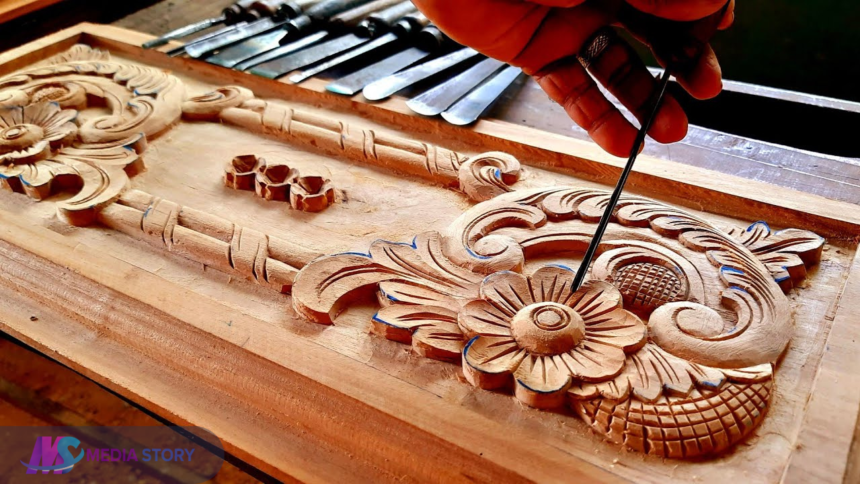Introduction
Wood carvings have been a cherished art form for centuries, blending creativity and craftsmanship. Whether you’re a beginner or an experienced artisan, understanding the techniques, history, and tools of wood carving can enhance your appreciation for this beautiful craft.
In this guide, we’ll explore the history of wood carvings, essential tools, popular styles, and expert tips to help you start your journey into wood carving.
The Rich History of Wood Carvings
Wood carving is one of the oldest forms of artistic expression. It dates back thousands of years and has been used in religious art, architecture, and everyday objects.
- Ancient Egypt – Egyptians carved intricate wooden sculptures of gods, pharaohs, and animals.
- Medieval Europe – Gothic cathedrals featured elaborate wooden altarpieces and church decorations.
- Asian Influence – Countries like China and Japan have a long history of wooden carvings in temples, furniture, and sculptures.
- African Tribes – African cultures are known for their carved masks and figurines, often used in rituals.
Today, wood carving continues to evolve, with modern artists pushing the boundaries of creativity.
Essential Tools for Wood Carving
To start wood carving, you’ll need the right set of tools. Here are some of the most commonly used ones:
1. Carving Knives
- Best for beginners
- Used for whittling and simple carvings
2. Chisels and Gouges
- Chisels: Straight-edged tools for cutting flat surfaces
- Gouges: Curved tools for creating deeper cuts
3. Mallet
- Used to apply controlled force on chisels and gouges
4. Rotary Tools (Dremel)
- Ideal for fine detailing and engraving
5. Sandpaper and Finishing Tools
- Helps smooth and polish the final piece
Bio Table
| Aspect | Details |
|---|---|
| Art Form | Wood Carving |
| Best for Beginners | Whittling, Relief Carving |
| Best Wood | Basswood, Pine, Walnut |
| Essential Tools | Carving Knife, Chisels, Mallet |
| Skill Level | Beginner to Expert |
| Common Uses | Sculpture, Decor, Furniture |

Types of Wood Used for Carving

Types of Wood Used for Carving
Not all wood is suitable for carving. Here are the best options:
Softwoods (Great for Beginners)
Basswood – Easy to carve, commonly used by beginners.
Pine – Readily available and affordable.
Cedar – Has a pleasant aroma and natural resistance to decay.
Hardwoods (For Advanced Carvers)
Oak – Tough and durable, excellent for detailed carvings.
Walnut – Rich color, commonly used for sculptures.
Mahogany – Smooth grain, perfect for intricate designs.
Popular Styles of Wood Carving
Different techniques define the style and appearance of wood carvings. Here are the most common ones:
1. Whittling
- The simplest form of wood carving using only a knife.
- Ideal for small figurines and rough designs.
2. Relief Carving
- Designs are carved into a flat wooden panel, creating a 3D effect.
- Common in decorative wall panels and furniture.
3. Chip Carving
- Small chips of wood are removed to form patterns.
- Often used in decorative wooden boxes and furniture.
4. Sculptural Carving
- Involves carving full 3D sculptures.
- Requires advanced skills and multiple tools.
Step-by-Step Guide to Wood Carving for Beginners
If you’re new to wood carving, follow these steps to start your journey:
Step 1: Choose the Right Wood
Beginners should start with softwoods like basswood or pine since they are easier to carve.
Step 2: Select the Right Tools
A carving knife, chisel, and mallet are essential for starting.
Step 3: Sketch Your Design
Draw a rough outline of your design on the wood before carving.
Step 4: Start with Basic Cuts
Use simple cuts and remove small amounts of wood at a time.
Step 5: Add Details and Finishing Touches
Once the main shape is carved, add finer details using a rotary tool or sandpaper.
Step 6: Apply a Protective Finish
Use wood stain, wax, or oil to protect and enhance the appearance of your carving.
Tips for Perfecting Your Wood Carving Skills
- Practice on scrap wood before starting a big project.
- Use sharp tools to make clean cuts and avoid injuries.
- Carve along the wood grain to prevent splintering.
- Work in a well-lit area for better visibility and precision.
- Patience is key – wood carving is a slow and detailed process.

FAQs

FAQs
1. What is the easiest wood to carve?
Basswood and pine are the easiest woods for beginners because of their soft texture.
2. Do I need expensive tools to start wood carving?
No, a simple carving knife and softwood are enough to start learning the basics.
3. How long does it take to learn wood carving?
It depends on your dedication, but beginners can create basic carvings within a few weeks of practice.
4. Can I use any type of wood for carving?
While you can carve most woods, some (like basswood and walnut) are better suited for different techniques.
5. How do I protect my wood carvings?
Apply a finish like wood oil, wax, or polyurethane to protect it from moisture and damage.
Conclusion
Wood carvings are a rewarding and timeless art form that allows for creativity and craftsmanship. Whether you’re a beginner or a seasoned carver, mastering the right techniques, tools, and wood types will help you create stunning works of art. Start with simple projects, practice regularly, and enjoy the beauty of handcrafted wooden pieces.







